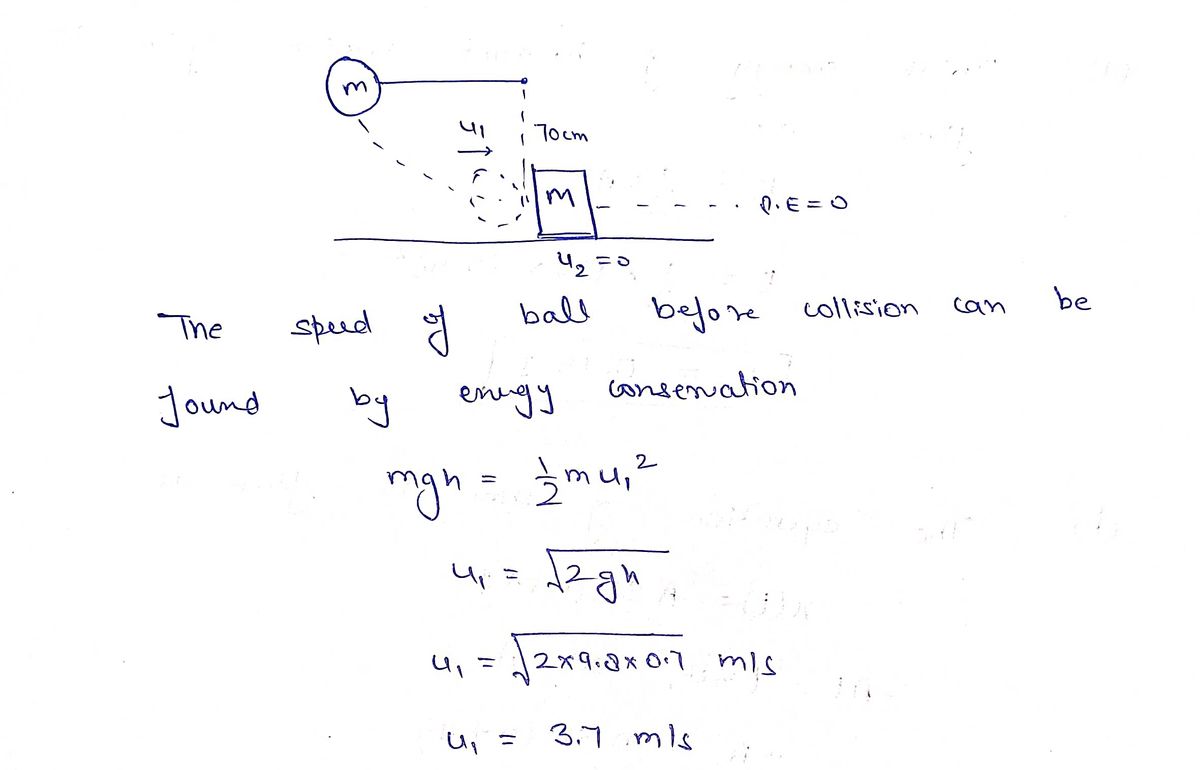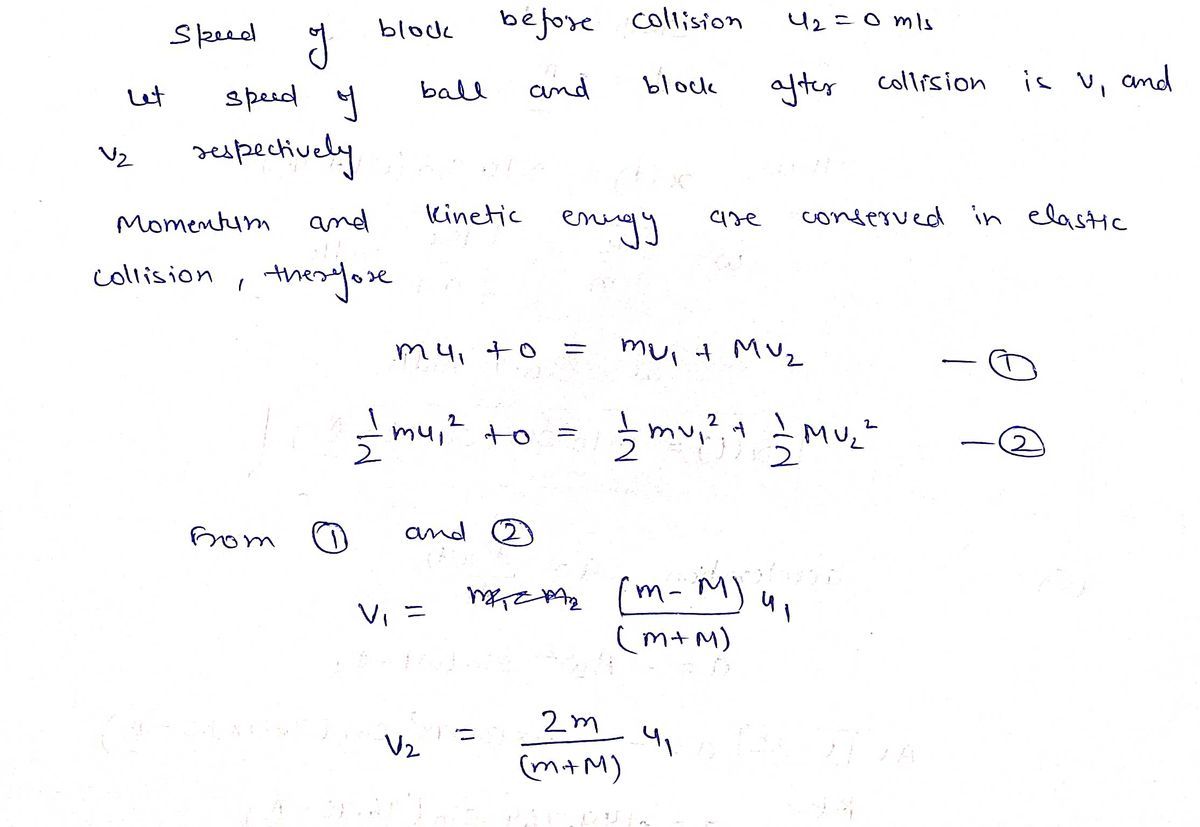A ball of mass 2.5 kg swings on the end of a 70 cm long string and collides with a 1.5 kg block as shown. Assume that the collision is perfectly elastic. a) What is the speed of the block immediately after the collision? b) How high does the ball rise after the collision?
Q: PART A. SPEED, VELOCITY, AND ACCELERATION Little Mario plays with his remote control car, and…
A: In case of uniform velocity the acceleration of body is zero
Q: package of mass mm is released from rest at a warehouse loading dock and slides down the…
A:
Q: The 5.0 MgMg truck and 1.7 MgMg car are traveling with the free-rolling velocities shown just before…
A: a) Using the law of conservation of momentum, mTuT+mCuC=mTvT+mCvC5.0 Mg30 km/h+1.7 Mg10 km/h=5.0…
Q: A 100-kg particle moves with an initial velocity of (4.0i, - 6.0j) m/s. If its velocity changes to v…
A:
Q: Open Response 5 This is a multi-part problem. Please answer all parts here. A 6 kg object moving to…
A:
Q: A car (m=1250kg) going 7.0 m/s strikes a resting car (m=900kg) the collide in an inelastic…
A: The expression for inelastic collision is m1v1+m2v2=m1+m2v Rearrange v=m1v1+m2v2m1+m2
Q: A ball of mass 2.5 kg swings on the end of a 70 cm long string and collides with a 1.5 kg block as…
A:
Q: A 2.5-kg ball and a 5.0-kg ball have an elastic collision. Before the collision, the 2.5-kg ball was…
A: m1 = 5 kgm2 = 2.5 kgv1i = 3.5 m/sKinetic energy of 2.5 kg object is to be calculated.
Q: A 0.02 kg bullet is fired into a 1.5 kg block that is initially at rest on a flat frictionless…
A: Given: The mass of the bullet is m1=0.02 kg. The mass of the block is m2=1.5 kg. The block is…
Q: Two particles of 4 kg and 2 kg, respectively, move on a surface without friction in opposite…
A:
Q: During a particular collision between two masses, 5.3 Joules of mechanical energy is lost during the…
A:
Q: A 5kg block sliding at2m/s to the right head on with 3 kg block that is sliding at 4m/s to the left…
A:
Q: Before an elastic collision of two balls of 2.0 kg each, the kinetic energies of two balls are…
A: Mass of first ball , m1 = 2.0 kg Mass of second ball, m2 = 2.0 kg Kinetic energy of m1 before…
Q: Two objects on ice moving at right angles to each other stick together at the origin and continue to…
A: Given data- Two objects on ice moving at right angles to each other stick together at the origin…
Q: (b) What is the y-component of the average velocity of the plane during the second leg of the trip,…
A: Velocity of the plane while traveling to the north east to city B. Hence plane travel from East (+x…
Q: Two 465g blocks of wood are 2 m apart on a frictionless table. A 15g bullet is fired at 419 m/s…
A:
Q: A 2.0-kg object moves to the right with a speed of 4.0 m/s. It collides in a perfectly elastic…
A: In a perfectly elastic collision Since kinetic energy remains conserved, So Kinetic energy before…
Q: A 7.3kg bowling ball collides with a 1.5kg pin that was at rest. Before the collision the ball speed…
A: Given: mass of ball, M= 7.3 kg mass of pin, m = 1.5 kg speed of ball before collision, U = 6 m/s…
Q: A 7,300-kg truck runs into the rear of a 1,000-kg car that was stationary. The truck and car are…
A: Mass of the truck ( M ) = 7300 kg. Mass of the car ( m ) = 1000 kg Speed of truck and car after…
Q: 7. Is the monmentum of a pendulum while it swings from one extreme to its opposite exuene conserved?…
A: Answer:- (B) Yes energy is being converted between potential and kinetic but the total momentum…
Q: A 320-g air track cart traveling at 1.25m/s suddenly collides elastically with a stationary 270-g…
A: The mass of the first air track cart, m1=320 g=0.320 kg The mass of the second cart, m2=270 g=0.270…
A ball of mass 2.5 kg swings on the end of a 70 cm long string and collides with a 1.5 kg block as shown. Assume that the collision is perfectly elastic.
a) What is the speed of the block immediately after the collision?
b) How high does the ball rise after the collision?



Step by step
Solved in 3 steps with 3 images

- Two particles approach each other with equal and opposite speed, v. The mass of one particle is m, and the mass of the other particle is nm, where n is just a constant factor. Snapshots of the system before, during, and after the elastic collision are shown. m Before nm What is the value of n? Collision V.final m n = After V nm After the collision, the first particle moves in the exact opposite direction with speed 1.30v, and the speed of the second particle, Unm,final, is unknown. nm, finalIn the figure below, a 3.1 kg box of running shoes slides on a horizontal frictionless table and collides with a 1.8 kg box of ballet slippers initially at rest on the edge of the table, at height = 0.40 m. The speed of the 3.1 kg box is 5.0 m/s just h before the collision. If the two boxes stick together because of packing tape on their sides, what is their kinetic energy just before they strike the floor? ។ hA child rolls a 4 kg ball with a speed of 6 m/s toward a 2 kg ball that is stationary. The two balls stick together after the collision. What is their velocity immediately after the perfectly inelastic collision?
- 3. This problem refers to the figure below: mmm There are 3 identical bobs of mass m hanging side-by-side. Two are then lifted to a height of h and released. The collisions in this problem are elastic. Answer the following questions: (a) Let's call the initial and final state immediately before and after the collision, respectively. Write down the initial momentum and kinetic energy of the system in terms of m and h. (b) Show that, after the collision, the left and center bobs rise to height h while the right bob becomes stationary. In particular, show that the center bob acts as if it were swinging freely as a lone pendulum.A 100-kg particle moves with an initial velocity of (4.0i, - 6.0j) m/s. If its velocity changes to v = (3.0i – 8.0j) m/s by the action of a force, determine The net work done on the particle. What principle would you use to solve this problem? The impulse on the particle. True or False: Impulse is equal to the rate of change of momentum.Sammy with a mass of 20 kg and his mother the mass of 40 kg are at rest 10 m apart. The father of mass 80 kg slides along the path at 15 m/s. He collides with the mother and she bounces ahead to collide with Sammy. If all collisions are perfectly elastic and one dimensional and there is no friction on the straight and level path, calculate the speed of Sammy
- a block with a mass of 0.5 kg is released from rest on a frictionless track at a distance 2.5m above the top of the table. it then collides elastically with an object having mass m2=1.0kg that is initially at rest on the table as shown in the figure. the table is h2=2.oo m . a)How far away from the bottom of the table do the objects land ? Hints : determine the velocities just after the collision . how high does object 1 travel back up the track. b) suppose the collision is inelastic , where does combined object land please see attached imageA 5 kg blob of clay is moving forward at 2 m/s when it has an inelastic collision with a 2kg blob of clay initially at rest. What will be the final velocity of the two blobs after they stick together?A ball of mass 500 g swings on the end of a 70 cm long string and collides with a 2.5 kg block as shown. Assume that the collision is perfectly elastic. a) What is the speed of the block immediately after the collision? b) How high does the ball rise after the collision?